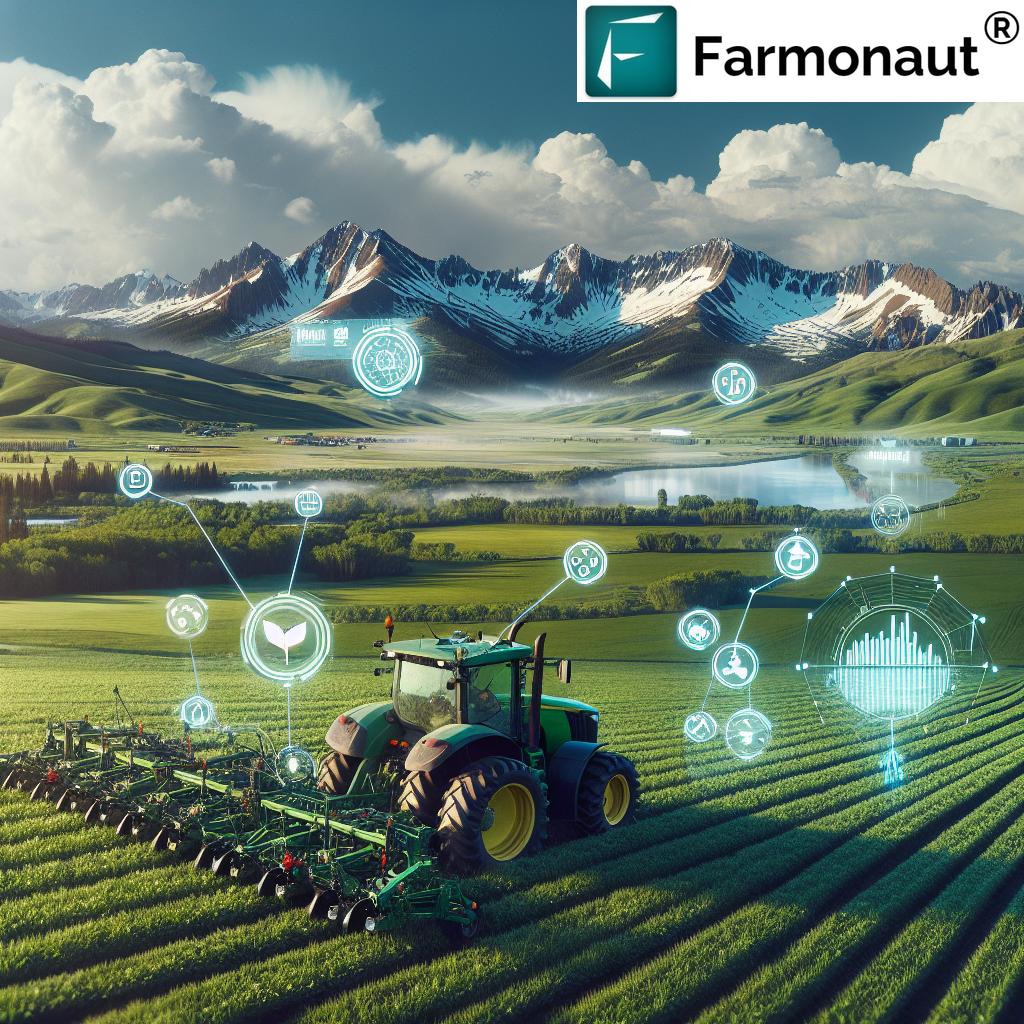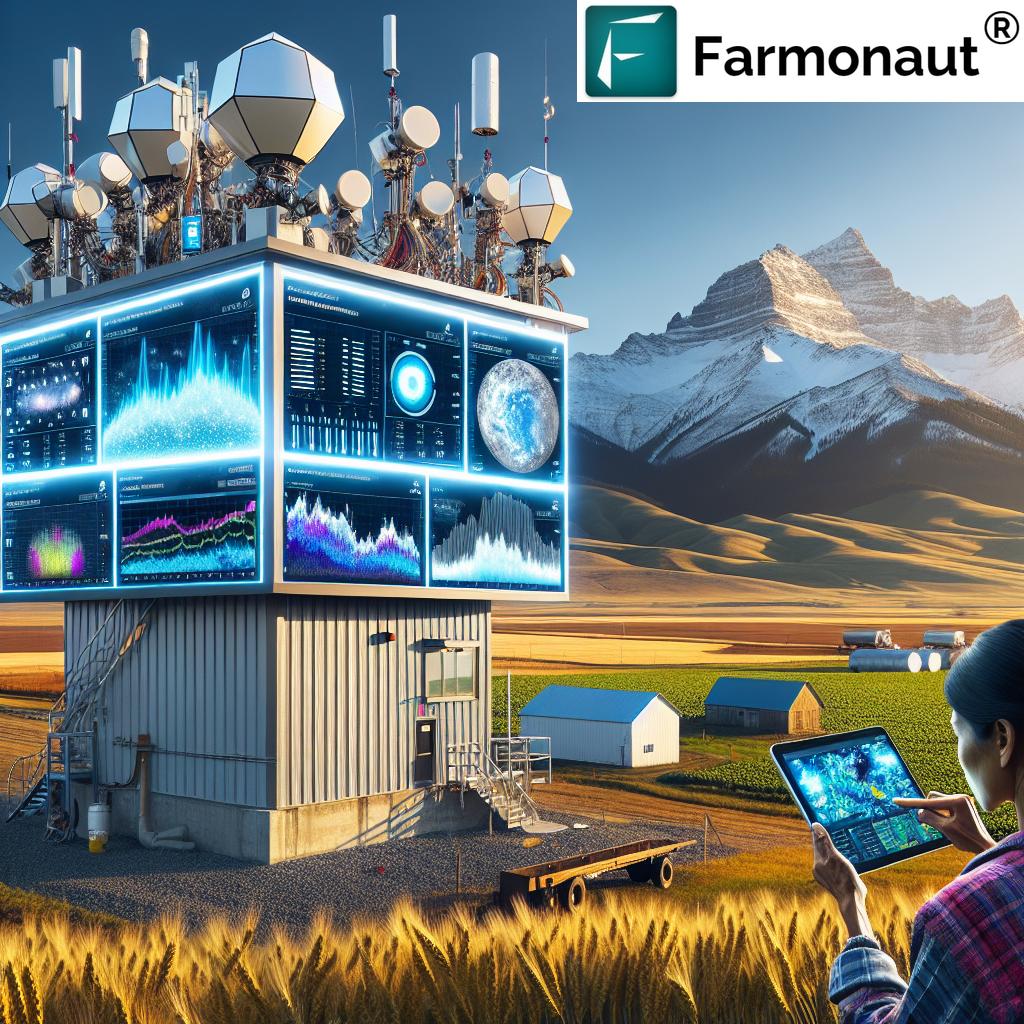Salmon Fish Farm USA: 2026 Sustainable Trends & Supplies
Meta Description: Salmon farm fishing in the USA is embracing sustainability in 2026 with new eco-trends, innovative supplies, and advanced technology to meet rising seafood demand responsibly.
Table of Contents
- Summary: Salmon Farming in 2025-2026 – Advancements, Sustainability, and Industry Outlook
- Did You Know?
- The Emergence of Salmon Fish Farms in the USA: A Sustainable Solution
- Sustainably Farmed Salmon: Meeting Consumer and Environmental Demands
- Sustainability Trends Shaping Salmon Farm Fishing by 2026
- Technological Advancements in Salmon Farm Operations
- Fish Farm Supplies & Infrastructure: Trends for 2026
- Comparison Table of Sustainable Practices & Estimated Impact in US Salmon Fish Farms (2026)
- Fish Farming USA: Regional Trends, Regulatory Drivers & Climate Risks
- Satellite-Based Resource Management & Sustainability Monitoring With Farmonaut
- Future Outlook: Transforming Salmon Fish Farm Sustainability Beyond 2026
- Trivia Spotlight
- FAQ: Salmon Fish Farm, Sustainability & Technology in the USA
- Conclusion
Summary: Salmon Farming in 2025-2026 – Advancements, Sustainability, and Industry Outlook
Salmon farming has rapidly emerged as one of the most significant sectors within global aquaculture, playing a crucial role in meeting seafood demand as wild stocks continue to decline. By 2025 and looking forward into 2026, technological innovation, sustainable practices, and a focus on ecological stewardship have begun reshaping salmon farm fishing in the USA. Salmon farm operations are increasingly characterized by:
- Integration of eco-friendly and responsible feed sourcing
- Emphasis on fish health and habitat conservation
- Technological advancements (like AI, underwater drones, and automated feeding)
- Improved supply chains and operational efficiencies in fish farm supply co sectors
As we delve into the latest innovations, regulatory drivers, and supply trends impacting the sustainability of salmon fish farms in the USA, it becomes clear that the industry’s outlook is shaped by the imperative of balancing economic growth with reduced environmental impact and enhanced seafood quality.
The Emergence of Salmon Fish Farms in the USA: A Sustainable Solution
Salmon fish farm operations have emerged as a cornerstone of seafood production in the United States. In recent years, the decline in wild stocks—driven by overfishing, climate shifts, and habitat disruption—has compelled producers to seek scalable alternatives. Salmon farming USA has risen to this challenge by deploying state-of-the-art aquaculture systems that prioritize sustainably farmed salmon, addressing both consumer demands and ecological responsibility.
Key producing regions in the USA, notably Maine, Washington, and Alaska, have demonstrated that salmon farm fishing can strike a balance between economic viability and environmental stewardship. Unlike traditional extraction from wild populations, modern salmon farms utilize efficient management systems, improved infrastructure, and stringent regulatory frameworks.
The move towards sustainability is not only a response to environmental impact, but also to shifting consumer preferences: an emphasis on product transparency, responsible sourcing, and health.
Sustainably Farmed Salmon: Meeting Consumer and Environmental Demands
Consumer demands for sustainably farmed salmon have never been higher. Influenced by both environmental activism and personal health consciousness, American and global seafood buyers are prioritizing options that reduce the ecological footprint and enhance product quality.
Key practices meeting these demands in salmon farm fishing include:
-
Responsible Feed Sourcing:
- Modern fish farm supply co options utilize feed composed of sustainably sourced fishmeal and innovative plant-based alternatives, reducing reliance on wild fish stocks, and lowering overall environmental impact.
-
Reduced Chemical Treatments & Disease Control:
- Farms emphasize limited use of antibiotics and chemical treatments, focusing instead on integrated disease management, biosecurity, and selective breeding for disease resistance.
-
Habitat Conservation & Waste Minimization:
- By deploying integrated multi-trophic aquaculture (IMTA) systems, salmon fish farms can grow complementary species—such as shellfish and seaweed—alongside salmon. This innovative approach enhances nutrient recycling and minimizes waste discharge.
To ensure global markets receive environmentally responsible seafood, certifications like those from the Aquaculture Stewardship Council (ASC) and GlobalGAP are increasingly required by retailers. These certifications confirm that farms adhere to rigorous social and environmental standards, promote animal welfare, and employ best practices in water quality management and disease control.
Smart purchasing decisions by retailers, alongside consumer awareness, are set to keep driving the sustainable farmed salmon movement—a trend projected to intensify through 2026 and beyond.
Sustainability Trends Shaping Salmon Farm Fishing by 2026
As the industry moves toward 2026, key sustainability trends are redefining farmed salmon production, especially in the USA. These advancements aim to reduce environmental impact, meet regulatory standards, and enhance supply chain efficiency.
1. Responsible Feed Formulations
- Innovations in sourcing sustainable fishmeal and plant-based alternatives decrease reliance on wild-caught fish, supporting marine biodiversity.
- Eco-friendly ingredients like soy, algae, and insect meal are integrated into salmon diets for lower carbon footprints.
2. Circular Aquaculture Systems & IMTA
- Integrated Multi-Trophic Aquaculture (IMTA): By cultivating shellfish and seaweed alongside salmon, farms repurpose waste (like nutrients and organic matter), which enhances marine health and minimizes pollution.
3. Climate-Smart Salmon Farm Infrastructure
- Closed Containment and Recirculating Aquaculture Systems (RAS): These inland systems isolate farms from natural waterbodies, vastly reducing risks of escape, disease transfer, and pollution.
- Advanced water recycling** and **filtration technologies** reduce freshwater use while maintaining optimal conditions.
4. Certification & Traceability
- Salmon farms aim for traceability using blockchain (see: Farmonaut Traceability Solutions) so consumers and retailers can verify the sustainability and origin of each farmed salmon product.
- Certifications such as ASC and GlobalGAP are being universally adopted—especially in US markets—promoting best practices in welfare, water, and disease management.
5. AI, Satellites & Data-Powered Management
-
Modern satellite monitoring and AI-based advisory systems (fully enabled by platforms like Farmonaut Large-Scale Farm Management Solutions) provide salmon farmers with:
- Real-time water quality insights
- Disease outbreak prediction
- Optimal feeding and harvesting schedules
- These innovations lead to strengthened operational infrastructure, resource optimization, and reduced production risks.
Certifications Shaping the Market
- Aquaculture Stewardship Council (ASC): Farms with ASC certification ensure reduced impact on water, improved welfare, and greater transparency—gaining wider market access (especially in North America and Europe).
- GlobalGAP: Recognized for compliance with social and environmental standards, covering everything from feed sourcing to animal welfare and operational efficiency.
Technological Advancements in Salmon Farm Operations: The 2026 Perspective
Technology remains a cornerstone of modern salmon fish farm operations, underpinning efforts to both raise productivity and reduce environmental pressure. As we look toward 2026, digital transformation and innovation are making farming more transparent, efficient, and sustainable than ever before.
Let’s explore the key technological advancements shaping salmon farm fishing across the USA and globally.
-
Automated Feeding Systems: Optimized, sensor-driven systems synchronize feed with fish appetite cycles, minimizing waste and optimizing growth.
Many fish farm supplies companies now offer monitored, cloud-based solutions for both offshore and inland farms. - Real-Time Water Quality Sensors & Underwater Drones: These devices track critical parameters—such as temperature, dissolved oxygen, and pH—alerting farmers to environmental shifts before crises develop.
- Genomic Selection and Disease Control: Advanced breeding programs produce salmon strains with superior disease resistance, decreasing dependency on antibiotics and chemical treatments.
- Recirculating Aquaculture Systems (RAS): By using RAS, farms (particularly those in inland US regions) gain biosecurity and drastically reduce environmental footprints compared to open-net pens.
- Blockchain-Enabled Traceability: Farmonaut blockchain solutions offer supply chain provenance, ensuring authenticity and boosting consumer trust.
- AI-Driven Insights for Disease Prediction & Resource Allocation: Platforms such as Farmonaut APIs permit integration with farm management systems, leveraging historical and real-time data for precise predictive modeling and risk mitigation.
Additionally, data integration tools streamline infrastructure management and allow fisheries to maintain rigorous compliance and certifications as regulations evolve.
Fish Farm Supplies & Infrastructure: Trends for 2026
Reliable, high-quality fish farm supplies and robust infrastructure are vital for the sustainability and operational efficiency of US salmon fish farms. By 2026, the fish farm supply co sector is seeing strong innovation across all areas—from feed technologies to automated farm monitoring.
The Role of Fish Farm Supply Companies in Modern Salmon Aquaculture
-
Advanced Cage & Net Technologies:
- Biodegradable netting and predator-resistant cages reduce escapes and ocean pollution while enhancing fish health.
- Anti-fouling materials** and **special coatings** reduce sea lice infestations, requiring fewer chemical controls.
-
Integrated Monitoring Systems:
- Automated platforms monitor feeding, water conditions, and fish health to alert farmers of risks and allowing precise management from anywhere.
- Farmonaut’s APIs (Farmonaut API for Satellite-Driven Monitoring) enable seamless software and hardware integration for comprehensive resource management.
-
Specialized Feed Designs:
- Custom blends address farm-specific health risks, local water quality conditions, and ecological demands.
-
Efficient Supply Chains:
- The rise of ‘just-in-time’ logistics lowers carbon footprints and ensures supply resilience even as market demands evolve rapidly.
-
Vaccines & Disease Control Solutions:
- The move towards targeted, environmentally safe vaccines** reduces prevalence of major salmon diseases.
Comparison Table of Sustainable Practices & Their Estimated Impact in US Salmon Fish Farms (2026)
| Sustainable Practice/Innovation | Description | Estimated Implementation Rate (USA, 2026) | Estimated Reduction in Environmental Impact (%) | Key Supplies/Technologies Used |
|---|---|---|---|---|
| Closed Containment & RAS | Inland recirculating aquaculture systems isolate salmon from natural waterbodies, recycle water. | 40% of new and retrofitted farms | Up to 70% (Nutrient & effluent reduction) | RAS tanks, sensor suites, automated recirculation, biofilters |
| Eco-Friendly, Plant-Based Feeds | Feeds based on algae, soy, and insect protein to reduce dependency on wild fishmeal. | >50% of all US salmon farms | Up to 20% (GHG and resource usage) | Fishmeal substitutes, custom feed blends, precision feeding systems |
| Integrated Multi-Trophic Aquaculture (IMTA) | Simultaneous farming of shellfish and seaweed absorbs salmon waste, enhancing nutrient recycling. | 30% of coastal/zoned farms | 35–50% (Waste and nutrient discharge reduction) | IMTA pens, adaptable netting, multi-species monitoring |
| Automated Water Quality Monitoring | AI-driven sensors and underwater drones track and adjust critical water parameters in real time. | ~60% of production facilities | 10–20% (Mortality and disease risk mitigated) | IoT sensors, underwater drones, satellite imagery |
| Blockchain Traceability & Certifications | Supply chains tracked via blockchain to ensure product origin and production transparency. | 70% of supply chain-ready US producers | 15–20% (Fraud & mislabeling eliminated) | Farmonaut blockchain traceability, RFID tags, digital ledger APIs |
| Biodegradable & Predator-Resistant Nets | Innovative netting reduces escapes and minimizes ocean plastic pollution. | ~35% of coastal/open ocean farms | 20–30% (Escape and debris risk) | Biopolymer nets, SMART cage tech |
Explore Advanced Salmon Farm Monitoring, Management & Traceability with Farmonaut
For salmon farm operations aiming to optimize resource management, reduce carbon footprints (Farmonaut Carbon Footprinting Solutions), and ensure full traceability of seafood from hatchery to table, Farmonaut enables next-generation capabilities via satellite, AI, and blockchain technology. Our proprietary platform provides up-to-date satellite imagery, real-time advisories, and blockchain-based traceability to help your farm comply with global certification standards, enhance operational efficiency, and demonstrate your sustainability commitments to consumers and regulators alike.
Fish Farming USA: Regional Trends, Regulatory Drivers & Climate Risks
The salmon fish farm industry in the USA is at the forefront of sustainability, drawing from major producing regions like Maine, Washington, and Alaska. Each region adapts cutting-edge aquaculture innovations to foster both economic growth and environmental stewardship. Here are some of the defining trends and challenges as we approach 2026 and beyond.
Key Trends:
-
Offshore Expansion and Habitat-Friendly Zoning:
- To reduce pressure on sensitive coastal ecosystems, offshore salmon farming is gaining traction. Deeper water and improved currents mean better water quality, fewer escapes, and less disease transmission.
-
Strengthened Regulatory and Certification Frameworks:
- US states continue bolstering regulations to prevent farmed-wild salmon interbreeding and ensure water quality—standards codified by ASC and GlobalGAP.
-
Climate Adaptation and Resiliency:
- Projects are under way using satellite data to monitor climate-induced temperature shifts and plan for ecosystem stressors. Farmonaut’s carbon footprinting features assist in identifying sustainability improvement areas and GHG mitigation strategies, which are key to meeting environmental goals for 2026.
-
Focus on Domestic & Local Supply:
- Building regional supply chains (fish farm supply co networks) boosts resilience, especially amid global trade volatility and shifting consumer preferences for locally sourced seafood.
Primary Challenges:
- Climate Variable Risks: Salmon’s health and productivity are sensitive to ocean temperature shifts; thus, climate monitoring is critical.
- Resource Constraints: Clean water access and habitat conservation are ongoing concerns amid expanding urbanization and land use changes.
- Regulatory Complexity: Navigating multi-level approvals for offshore expansion and new technology adoption remains a hurdle for fish farmers.
- Market Pressure: Meeting demanding global markets calls for consistent, certified, and traceable products—standards readily supported by Farmonaut’s satellite and blockchain products.
For further support in these areas—such as loan verification and insurance optimization—please explore our satellite-based loan/insurance solutions for aquaculture.
Satellite-Based Resource Management & Sustainability Monitoring With Farmonaut
At Farmonaut, we offer a powerful platform for real-time monitoring, resource management, and traceability—tailored for new-generation salmon fish farms seeking to strengthen sustainability and satisfy increasingly rigorous supply chain and certification standards. Our end-to-end solutions span:
-
Satellite-Based Environmental Monitoring:
- Through multispectral imagery, we help track water quality, infrastructure health, and vegetation status, facilitating smarter, faster decision-making for operational efficiency and compliance.
-
AI-Based Advisory & Predictive Analytics:
- With the Jeevn AI system, actionable insights on climate patterns, fish health, and infrastructure risks are at your fingertips—on mobile or web. This not only optimizes farm management but also reduces losses, energy use, and disease risks.
-
Blockchain Traceability:
- Advanced traceability solutions ensure US farms easily comply with ASC, GlobalGAP, and emerging retailer standards, granting access to high-value global markets.
-
Carbon Footprint and Environmental Impact Tracking:
- Producers can monitor and report carbon emissions—showcasing environmental responsibility, supporting goal tracking (such as the anticipated 30% emissions reduction), and opening doors to carbon credits and new incentives.
-
Fleet and Equipment Optimization:
- With our Fleet Management tools, users rapidly analyze logistics, equipment utilization, and reduce fuel consumption and maintenance costs—significantly cutting both costs and carbon output in aquaculture operations.
Our technology integrates seamlessly into your workflow—mobile, web, or API—and offers scalable solutions for both new and established fish farms nationwide.
Unlock Satellite-Driven Sustainability & Traceability
Explore our tailored Farmonaut subscription plans for salmon aquaculture and farm supply management:
FAQ: Salmon Fish Farm, Sustainability, and Technology in the USA
What are the primary challenges faced by salmon fish farm operations in the USA?
The main challenges involve environmental impact (such as managing water quality and minimizing escapes), resource constraints, disease control, and adapting to climate variability and regulatory demands. These are being addressed via improved sustainable management practices and technological innovation.
How do sustainable feeds differ from traditional fishmeal?
Sustainably farmed salmon feeds incorporate plant-based proteins (like soy and algae), insect meal, and processed byproducts to reduce reliance on wild-caught fishmeal. This not only helps conserve marine resources but also lowers greenhouse gas emissions.
Why are certifications like ASC and GlobalGAP important for salmon farm fishing?
These certifications guarantee farms adhere to the highest social and environmental standards, ensuring best animal welfare practices, water management, and product traceability. Certification is increasingly required by retailers and international markets.
How do platforms like Farmonaut support salmon farmers?
We offer satellite-based monitoring, predictive analytics, and blockchain traceability for real-time farm management, regulatory compliance, and resource optimization. This empowers farmers to respond quickly to changing environmental conditions and market requirements.
What future innovations will shape salmon farming in the USA?
Future growth hinges on expanded use of climate-smart, circular farming systems, further automation (AI, underwater drones, IoT sensors), enhanced blockchain traceability, and deeper integration with environmental monitoring technologies like those offered by Farmonaut.
Future Outlook: Transforming Salmon Fish Farm Sustainability Beyond 2026
By 2026 and beyond, salmon farming USA and global stakeholders will continue to push the boundaries of sustainability, technology integration, and environmental responsibility. Markets increasingly require transparency, traceability, and climate action from all seafood producers. Innovations in circular aquaculture, alternative feeds, operational AI, and blockchain-inspired traceability will remain at the forefront.
The sector’s pivotal challenges revolve around:
- Reducing carbon footprints and waste
- Adapting to climate-related environmental changes
- Raising industry standards for quality, welfare, and traceability
- Building resilient, localized supply chains in response to global market dynamics
Farmonaut remains committed to enabling these transformations by making advanced, satellite-driven, and AI-powered solutions accessible across all aquaculture sectors.
For salmon farms in the USA, now is the time to invest in proven resource management tools, comprehensive environmental impact monitoring, and world-class traceability to stay competitive and sustainable in the rapidly evolving seafood landscape.
Conclusion
The journey toward a sustainable, efficient, and resilient salmon fish farm industry in the USA is already well underway. By prioritizing environmental stewardship, embracing technological advancements, and maintaining rigorous certification and traceability standards, US salmon producers are poised to lead the world in sustainably farmed salmon.
Whether through integrated farm systems, eco-friendly feed, superior fish health management, or satellite-powered resource optimization, the future of salmon farming promises higher efficiency, lower ecological impact, and more reliable seafood supplies for generations to come.
For aquaculture businesses, now is the ideal moment to harness large-scale management platforms, leverage APIs for data integration, integrate advanced blockchain traceability, and adopt real-time carbon footprint monitoring to ensure compliance, efficiency, and market trust.
Salmon farm fishing is not just about meeting demand—it’s about balancing economic growth with planetary health, resource sustainability, and transparent operations throughout the global seafood chain. The innovations and trends unfolding today—especially across the United States—will define the standard for responsible aquaculture in 2026 and long into the future.














